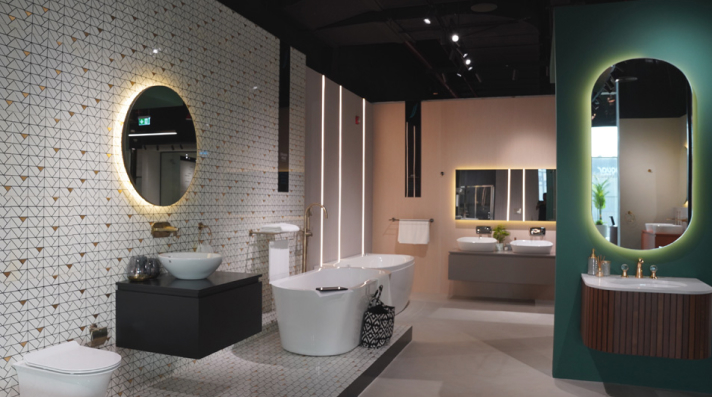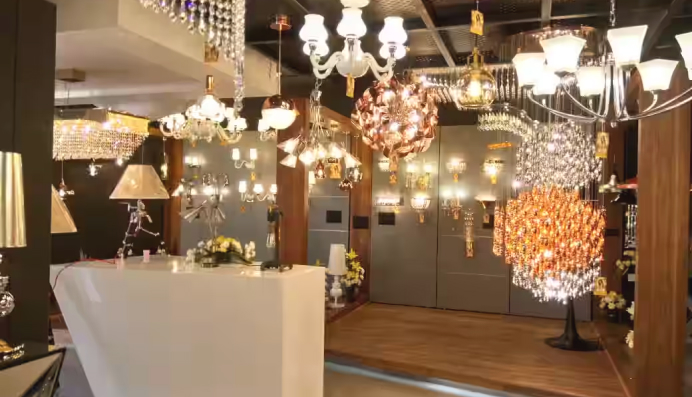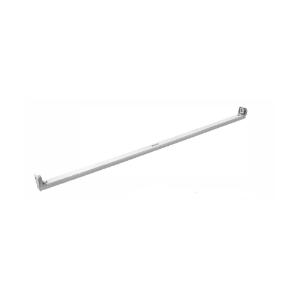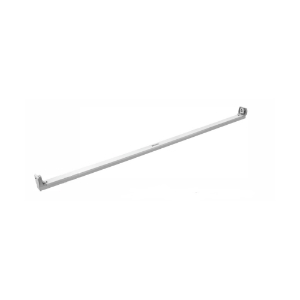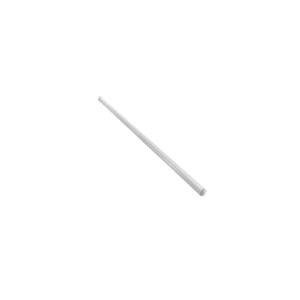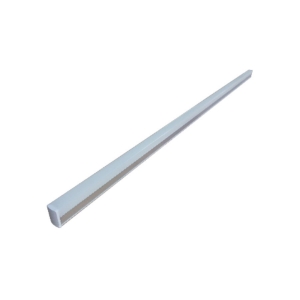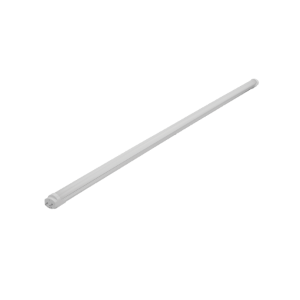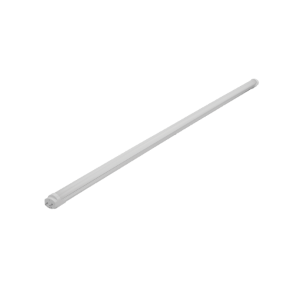We use cookies to deliver the best possible experience on our website. By continuing to use this site, or closing this box, you consent to our use of cookies.
- Global
- ASIA PACIFIC
- MIDDLE EAST
- AFRICA
- EUROPE

- Home >>
- Lighting >>
- Indoor Lighting >>
- LED Battens
LED Battens
Filters
Sort by
Commercial LED Battens
Welcome to Jaquar, a global brand renowned for its innovative bathware and solutions. In our commitment to enhancing everyday experiences, we proudly introduce our range of commercial LED battens. Designed to illuminate commercial and industrial spaces with efficiency and style, our LED battens combine cutting-edge technology with Jaquar's signature quality and reliability. From tube lights to glaze fittings and unilite fixtures, our commercial LED battens offer superior illumination tailored to meet the diverse needs of modern businesses. Explore our collection and discover how Jaquar is redefining lighting solutions for commercial environments worldwide.
Types Of Commercial LED Battens Fittings:-
- 01
Tube Lights
Tube lights are designed to resemble traditional fluorescent tube lights but use LED technology for improved efficiency and longevity. They are used in offices, retail spaces, warehouses, and other commercial environments where long-lasting, energy-efficient lighting is required.
- 02
LED Glaze
LED glaze batten fittings feature a diffuser cover made of translucent material that helps distribute light evenly and reduce glare. The glaze cover creates a softer, more diffused lighting effect compared to bare LED tubes, making them suitable for areas where glare needs to be minimised, such as offices, classrooms, and healthcare facilities.
- 03
LED Unilite
LED unilite batten fittings are characterised by their sleek and compact design, often featuring a slim profile and integrated LED modules. These fittings are ideal for industrial plants, factories and shop floors. Like other LED batten fittings, LED unilite fixtures offer energy savings, a long lifespan, and low maintenance requirements.
- 04
Pride
This weatherproof fitting offers bright and efficient lighting with options for different colour temperatures to suit various indoor environments. With high-quality construction and multiple protections, including IP65 ingress protection and IK02 impact protection, it ensures safe and long-lasting performance. Ideal for indoor lighting applications where reliability and durability are essential.
Features of Commercial LED Tube Lights :
- Energy Efficiency: LED tube lights consume significantly less energy compared to traditional fluorescent tubes. They can provide the same level of brightness while consuming up to 50-60% less electricity, resulting in substantial energy savings over time.
- Long Lifespan: They can last anywhere from 25,000 to 50,000 hours or more, depending on the quality of the LEDs and the operating conditions. This longevity reduces the frequency of replacement and maintenance, saving both time and money.
- Instant Start-up: They turn on instantly without any warm-up time. Unlike fluorescent tubes, which may flicker or take a few seconds to reach full brightness, LED tubes provide immediate illumination, making them ideal for applications where instant lighting is required.
- Durability: LED Batten lights are more durable and resistant to shock and vibration. They don't contain fragile filaments or glass components, reducing the risk of breakage during handling, transportation, or operation. This durability makes them suitable for demanding environments such as warehouses, factories, and outdoor installations.
- Mercury-Free: Unlike fluorescent tubes, which contain mercury, batten lights are mercury-free. This not only makes them safer to handle and dispose of but also reduces environmental impact, as mercury is a toxic substance that can harm human health and ecosystems if released into the environment.
- Colour Temperature Options: LED tube lights are available in various colour temperatures, ranging from warm white (2700K-3500K) to cool white (4000K-6500K) and daylight (6500K+). Businesses can choose the appropriate colour temperature to create the desired ambience or meet specific lighting requirements for different spaces.
- High Color Rendering Index (CRI): Many commercial LED tube lights have a high colour rendering index (CRI), which measures the light source's ability to accurately render colours compared to natural sunlight. High CRI LED tubes produce more vibrant and true-to-life colours, making them suitable for applications where colour accuracy is important, such as retail stores, art galleries, and showrooms.
- Compatibility with Existing Fixtures: LED tube lights are designed to retrofit into existing fluorescent tube fixtures without the need for major modifications or rewiring. This makes it easy for businesses to upgrade their lighting systems to LED technology without incurring significant installation costs or disruptions to operations.
Power Consumption Options
The LED Battens are available in various power consumption options starting from 10W up to 40W.
Colour Finishes Available
The LED Battens come in different colour settings such as Cool White, Neutral White, and Warm White.
Why Choose Jaquar for Commercial Batten Lights?
- 01
Finishes
Jaquar uses high-quality materials such as aluminium, stainless steel, and polycarbonate. You can choose a wide range of premium finishes and durable materials according to your requirements.
- 02
Unmatched Warranty
Jaquar provides a 10-year lifetime warranty on their products, making it the first choice amongst premium lighting solutions
- 03
Longer Life
Jaquar is known for its durable materials that resist tarnishing and corrosion. The high-pressure die-cast aluminium housing and impact-resistant polycarbonate lens protect the lights for many years.
- 04
Jaquar Care
At Jaquar, we care for our customer’s needs and are always at their service. Our customer support staff are always available to guide you in buying the product of your choice.
FAQs
Q. What is the lifespan of Jaquar's commercial LED batten lights and how often do they need to be replaced?
A. The lifespan of Jaquar’s commercial LED batten lights is more than 50,000 Hours making them long-lasting for years.
Q. Can Jaquar's LED batten lights be used in damp or outdoor commercial spaces?
A. Yes, Jaquar’s LED batten lights are weather protectant and can be used in damp or outdoor commercial spaces.
Q. Can Jaquar's commercial LED tube lights be used in emergency lighting?
A. Yes, Jaquar’s commercial LED tube lights can be used in emergency lighting situations such as power failure or critical situations.
Q. Do Jaquar's LED batten lights produce flicker-free illumination for optimal visual comfort?
A. Yes, Jaquar’s LED batten lights have an instant start-up feature, which produces flicker-free illumination for optimal visual comfort.
Q. Do Jaquar's LED batten lights emit UV or IR radiation?
A. No, Jaquar’s LED batten lights are eco-friendly and sustainable. They do not emit UV or IR radiation.
- LED bulbs are small and light. The size of a tube light or a fluorescent bulb is relatively large. The average LED bulb lasts 60000 hours. The life expectancy of a tube light is ten thousand hours. Compared to LED bulbs, this is six times less.
- Compared to tube lights, LED Bulbs use five times less energy to provide the same level of illumination. The tube light consumes energy five times compared to LED bulbs.
- LED bulbs are ideal for directional lighting applications such as flashlights and desk lamps. LEDs are also used in vehicle headlights and status lights in electrical equipment. Full-size tubes are appropriate for vast places like warehouses where focused light isn’t required.
- The efficiency of LED lights is very high. In comparison to ordinary incandescent bulbs, tube lighting has high efficiency. However, compared to LED bulbs, it is less efficient and makes it clear that LED bulbs are more efficient than tube light, and you can get yourself some of the best-LED bulbs from Jaquar.
- Cleat Wiring: Ordinary VIR or PVC insulated wires (sometimes encased and weatherproof cable) braided and compounded are secured on walls or ceilings by porcelain cleats, plastic, or wood. Because cleat wire is a temporary wiring system, it is not ideal for home use. The cleat wiring method is no longer in use.
- Casing and Capping Wiring: Casing and capping wiring systems were popular in the past, but Conduit and encased wiring systems have rendered them obsolete. VIR or PVC cables and any other permitted insulated cable were utilized in this type of wiring.
- Batten Wiring: This type of wiring uses TRS cables that are single-core, double core, or three core with a circular, oval shape. Single-core cables are the most common choice. TRS cables are chemical, water, and steam resistant; however lubricating oil has a minor impact on their performance. TRS wires run on a 10mm thick, well-seasoned and straight teak wood batten.
- Lead Sheathed Wiring: Conductors are insulated with VIR and covered with an outer sheath of a lead aluminum alloy containing roughly 95% lead in this form of wire. Cables were protected from mechanical damage, moisture, and air corrosion by the metal wrapping.
- Conduit Wiring: Surface conduit wiring occurs when conduits are put on the roof or wall. In this wiring approach, holes are drilled through the wall at equal intervals, and the tube is fitted using rawl plugs. Concealed conduit wiring is when the conduits are hidden inside the wall slots with the help of plastering.
- Turning off lights and appliances when they are not in use is a simple way to save energy. You can also save energy by doing household duties by hand, such as hanging your clothes to dry instead of putting them in the dryer or hand-washing your dishes.
- Traditional lighting such as fluorescent and incandescent lights are up to 80% less efficient than LED lights. Only 5% of the energy in LEDs is squandered as heat, whereas 95% is transformed into light. Compared to fluorescent lights, which convert 95% of their power to heat and only 5% to light, this is a huge difference, from replacing traditional incandescent lights with LED lights.
- Appliances account for around 13% of total household energy use on average. When buying a device, keep two numbers in mind: the initial purchase price and the annual operating cost. Although energy-efficient appliances may cost more upfront, their operational costs are typically 9 to 25% cheaper than conventional versions.
- While looking for an energy-efficient light, search for a Jaquar label, which is a federal assurance that the light will use less energy while in use and when not in use than regular models. The amount of energy saved varies depending on the light.
- The CFL is a light bulb that produces light through fluorescence, whereas the LED has visible light using a semiconductor diode. The CFL operates on the ionization concept. LEDs, on the other hand, work on the principle of electroluminescence. The diode emits light when the current passes across it in this phenomenon.
- When compared to LEDs, CFLs consume more energy. Because CFLs employ mercury, ionization demands more electricity. The CFL includes mercury vapor inside the glass tube, which is harmful to living creatures’ health, but the LED does not.
- Because CFL lights contain dangerous mercury vapor, they are difficult to destroy. The mercury vapor harms human and environmental health, but LEDs are easy to destroy because they are free of poisons and metals.
- When compared to LEDs, CFLs are more efficient. The luminous flux emitted by the bulbs determines the bulb’s efficiency. The visible light rays, which are measured in Lumens, make up the luminous flux. As a result, a bulb with a high Lumens per watt is regarded to be more efficient.
- CFLs have a lower turn-on intensity than LEDs because they contain mercury vapor, which takes time to ionize. The cost of a CFL is higher than that of an LED. CFLs require additional components, such as gas-filled tubes and an electrical component, which raises the price.
- Leaks can waste a lot of energy, and fixing them can save you a lot of money right away. According to reports, a compressor’s output might be reduced by 20 to 30% due to leakage. They may also reduce your equipment’s effectiveness. Missing seals or welds, loose tubes and hoses, and old materials are all familiar sources of leaks.
- Because manufacturing buildings must be well-lit, energy-efficient lighting and fitted effectively. Businesses can save energy using industrial compact fluorescent light bulbs (CFLs) or light-emitting diodes (LEDs). Lights in non-essential locations should also be turned off or removed, which you can get from the varied range of Jaquar lights.
- Electricity runs almost all of the electronics at your facility. Shutting down equipment at the end of the day might seem obvious, but it’s easy to neglect. Remind your staff to turn off their laptops and other devices or put them into sleep mode when they are not in the office, whether for a few hours or a lengthy vacation.
- LEDs are the only light sources that can be customised to give the proper spectrum and do fantastic things for plant growth because they are monochromatic sources and come in a wide variety of pure hues. Plants grow faster and healthier under LEDs than under other, more traditional lighting techniques like HPS, and even better than under natural sunshine if the LEDs are suitable.
- Not A whole spectrum of colours is present in all light sources; however, specific light sources only comprise a portion of the range. On the other hand, Sunlight encompasses all of the spectrum colours and provides energy to plants, triggering metabolic responses or influencing behaviour. Plants respond differently to different shades of LED chips that are installed inside the light.
- Red and blue are the two most critical light colours to use in an LED bulb. The colour red is essential for photosynthesis and stems elongation inhibition. Furthermore, it informs the plants that there are no other plants above them, allowing them to develop freely. Stomatal opening, stem elongation inhibition, leaf expansion, and curving toward light are all stimulated by blue.
- Plants can be grown in the house with regular LED bulbs, but only to a limited extent. Because blue plays such a significant role, a 6000K CC cool-white LED with a higher concentration of blues is chosen over a warm-white LED with a lower concentration of blue and a more significant red concentration. In either case, the green section of the spectrum wastes energy. The total cost of fuel used will determine the viability of bio-products. Thus go for a blue and red light.
- There are a lot of low-cost brands that produce third-grade items. LED lamps are made up of individual light-emitting diodes that might cause eye damage if viewed directly. That’s why these come with a diffuser for indoor use and a lens for outdoor lighting such as street lights and floodlights.
- You will be able to see the individual diodes if the diffuser is also of poor quality, which can hurt and harm your eyes. Jaguar, for example, is a high-quality brand. The majority of modern street lighting does not have lenses on the diodes. This is done to save money because, under government procurement, the lowest bidder gets the order, even if he compromises on quality.
- When it comes to choosing LED light that is good for your eyes, color is also crucial. It is beneficial for your eyes to select lights that are 5700K; the best technique is to look for a bluish hue. If the LED has a bluish tint, it does not have a diffuser. When purchasing LEDs, look for reputable brands or those that do not have a bluish hue.
- Fluorescent lights contain mercury, a toxic substance that poses a waste disposal problem when the light is turned off. A limited quantity of hazardous mercury is released as a gas by broken bulbs, while the remainder is trapped in the glass itself.
- Fluorescent lights are omnidirectional, which means Light is emitted at a 360-degree angle. Because at least half of the light must be reflected and redirected to the desired location, this is a significant system inefficiency. It also means that more light fixture accessories are needed to reflect or focus the bulb’s luminous output (thus increasing unit costs).
- In comparison to other lighting technologies, LEDs have an extraordinarily long lifespan (including fluorescent lights). New LEDs have a life expectancy of 50,000 to 100,000 hours or more. In comparison, the average lifespan of a fluorescent bulb is only 10-25 percent of that of an incandescent light.
- In comparison to other commercially available lighting technologies, LEDs are particularly energy-efficient. There are various reasons for this, including the fact that they lose relatively little energy in the form of infrared radiation (far less than most conventional lights, including fluorescent lights), and they emit light in a specific direction.
- Turning off lights and appliances when they are not in use is a simple way to save energy. You can also save energy by doing household duties by hand, such as hanging your clothes to dry instead of putting them in the dryer or hand-washing your dishes.
- Traditional lighting such as fluorescent and incandescent lights are up to 80% less efficient than LED lights. Only 5% of the energy in LEDs is squandered as heat, whereas 95% is transformed into light. When compared to fluorescent lights, which convert 95% of their power to heat and only 5% to light, this is a huge difference, hence replacing traditional incandescent lights with LED lights.
- Appliances account for around 13% of total household energy use on average. When buying a device, keep two numbers in mind: the initial purchase price and the annual operating cost. Although energy-efficient appliances may cost more upfront, their operational costs are typically 9 to 25% cheaper than conventional versions.
- While looking for an energy-efficient light, search for one with a Jaguar label, which is a federal assurance that the light will use less energy while in use and when not in use than regular models. The amount of energy saved varies depending on the light.
- Traditional fluorescent tubes may only last 34,000 hours, whereas Energy Focus LED lights have been tested for over 70,000 hours. We even back up our statements with a 10-year end-to-end warranty for most of our LED tubes and luminaires. Imagine going ten years without changing a single lightbulb!
- Focused Energy LEDs are self-contained, which means they function without use of a ballast. A ballast powers fluorescent lighting. Just like tubes, ballasts wear out and need to be replaced. The LED drivers and LED chips are integrated inside the tube itself in LED lights. So the only item you have to replace when the light goes out is the lamp itself.
- Traditional lighting such as fluorescent and incandescent lights are up to 80% less efficient than LED lights. Only 5% of the energy in LEDs is squandered as heat, whereas 95% is transformed into light. Compared to fluorescent lights, which convert 95% of their power to heat and only 5% to light, this is a huge difference.
- There are no harmful ingredients in LED lights. Fluorescent strip lights, which contain hazardous compounds such as mercury, are currently used in most offices. When disposed of in landfill waste, this will pollute the environment. Switching to LED reduces the cost and time constraints of compliant disposal while also helping to conserve the environment. Disposal must be arranged through a licensed trash carrier.
Copyright © 2025 Jaquar UAE. All rights reserved.
Powered by nopCommerce.

